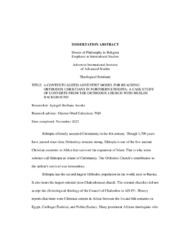| dc.description.abstract | Ethiopia officially accepted Christianity in the 4th century. Though 1,700 years have passed since then, Orthodoxy remains strong. Ethiopia is one of the few ancient Christian countries in Africa that survived the expansion of Islam. That is why some scholars call Ethiopia an island of Christianity. The Orthodox Church’s contribution to the nation’s survival was tremendous.
Ethiopia has the second largest Orthodox population in the world, next to Russia. It also hosts the largest oriental (non-Chalcedonian) church. The oriental churches did not accept the christological theology of the Council of Chalcedon in AD 451. History reports that there were Christian centers in Africa between the 1st and 6th centuries in Egypt, Carthage (Tunisia), and Nubia (Sudan). Many prominent African theologians who
influenced early Christianity emerged from these Christian centers. However, many of them were ill-fated and got destroyed, while others became weak because of the emergence of Islam in the 7th century.
According to the 2007 Ethiopian census, 44% of the population belonged to the Ethiopian Orthodox Church. Also, that but the Ethiopian Orthodox Christians are considerably more religious than Orthodox Christians in other parts of the world. Studies show that of the 50,000,000 adherents, 78% attend weekly and 65% attend daily services, while in Russia 6% attend weekly and 18% attend daily church services (Pew Research Center, 2017).
The Orthodox Church fused Christianity, Judaism, and paganism. Many of the Old Testament rituals are still practiced by the church. Practically, the tradition of the fathers of the church has more prominence than the Bible. The believers are sincere Christians. They prefer to read the Psalms and other prayer books for their morning devotional and to attend church services regularly to grow in their knowledge of the Word of God. They attend daily and weekly church services for their spiritual nourishment.
Northern Ethiopia is the origin of the Ethiopian Orthodox Church. The northern part of the country constitutes the Amhara and Tigray regions. The people of the Amhara and Tigray regions are considered the protectors of the faith. A great number of the clergy are from northern Ethiopia. They spread the Orthodox faith all over the country and uphold the church.
The Seventh-day Adventist mission spent 97 years in north Ethiopia. However, the growth of the Adventist Church is insignificant. The past experience shows that the
northern Orthodox Christians, including those with Muslim background, are highly resistant to the everlasting Gospel presented by the Adventist Church. This research employed a qualitative explanatory case study approach. The purpose of the study is to develop a contextual missiological model for reaching out to Orthodox Christians with Muslim background in northern Ethiopia. It seeks to explore and analyze the background of the northern Ethiopian Orthodox Christians with Muslim background and identify factors that created barriers that resulted in resistant attitude to the gospel truth. | en_US |

